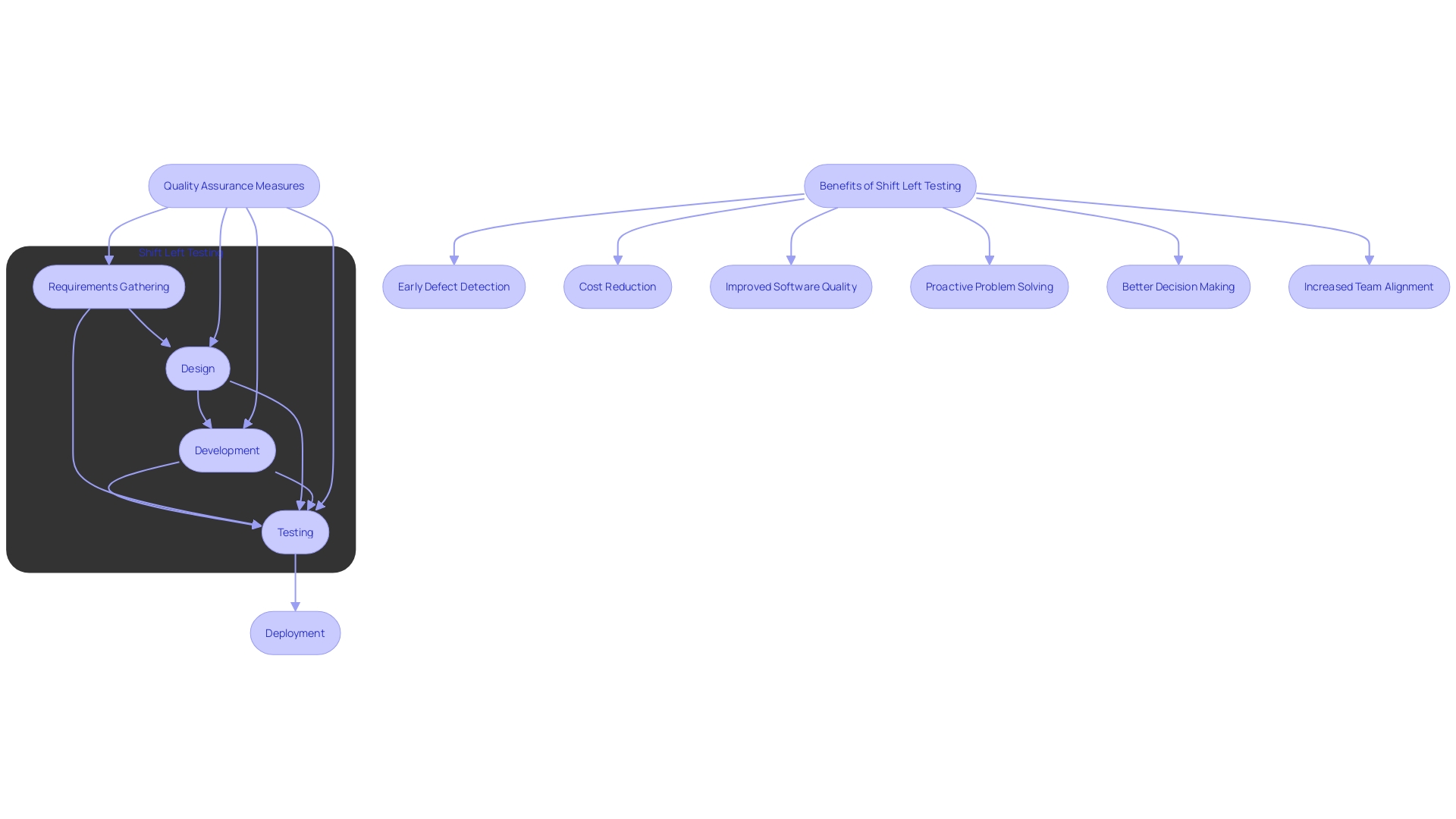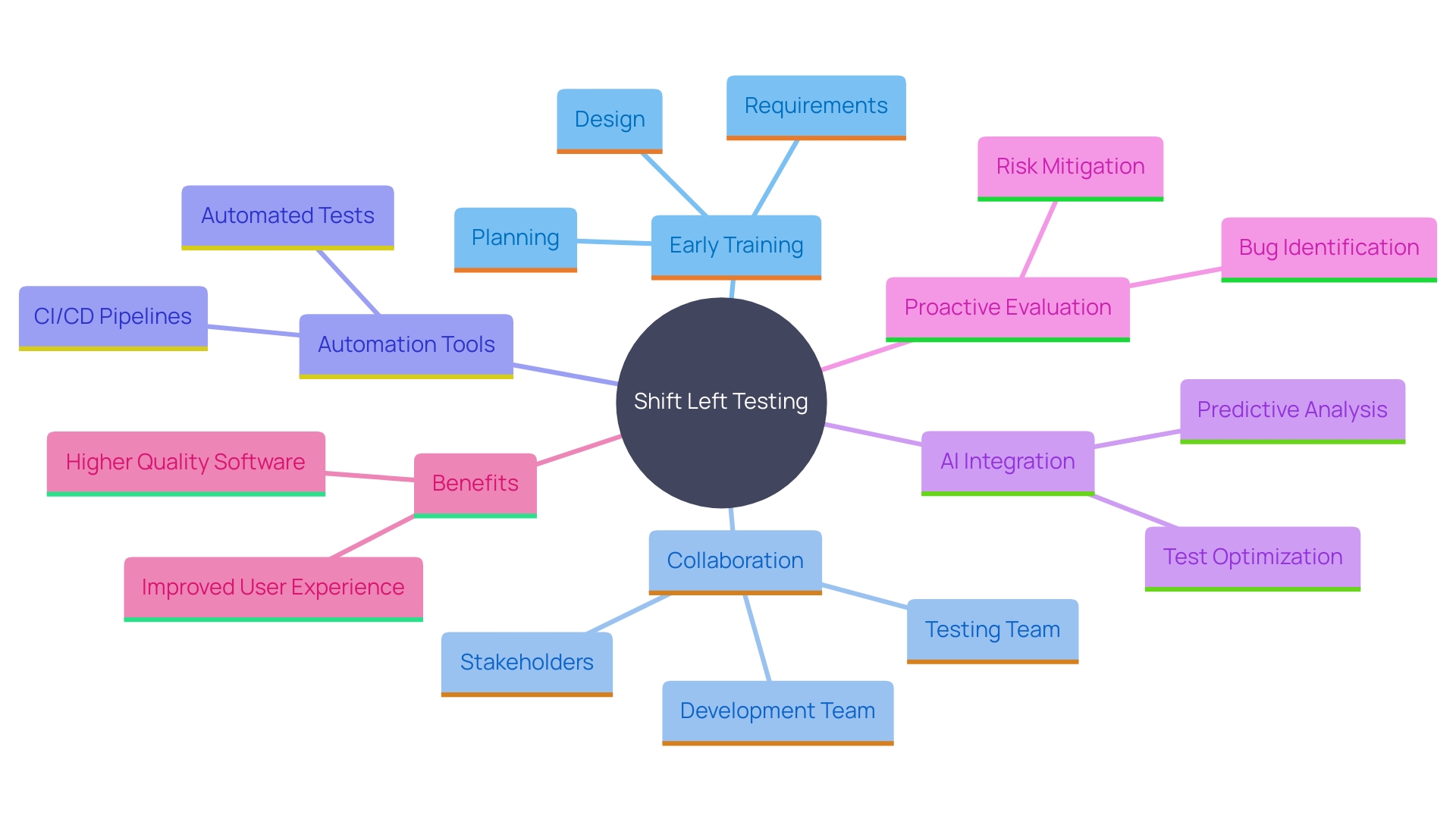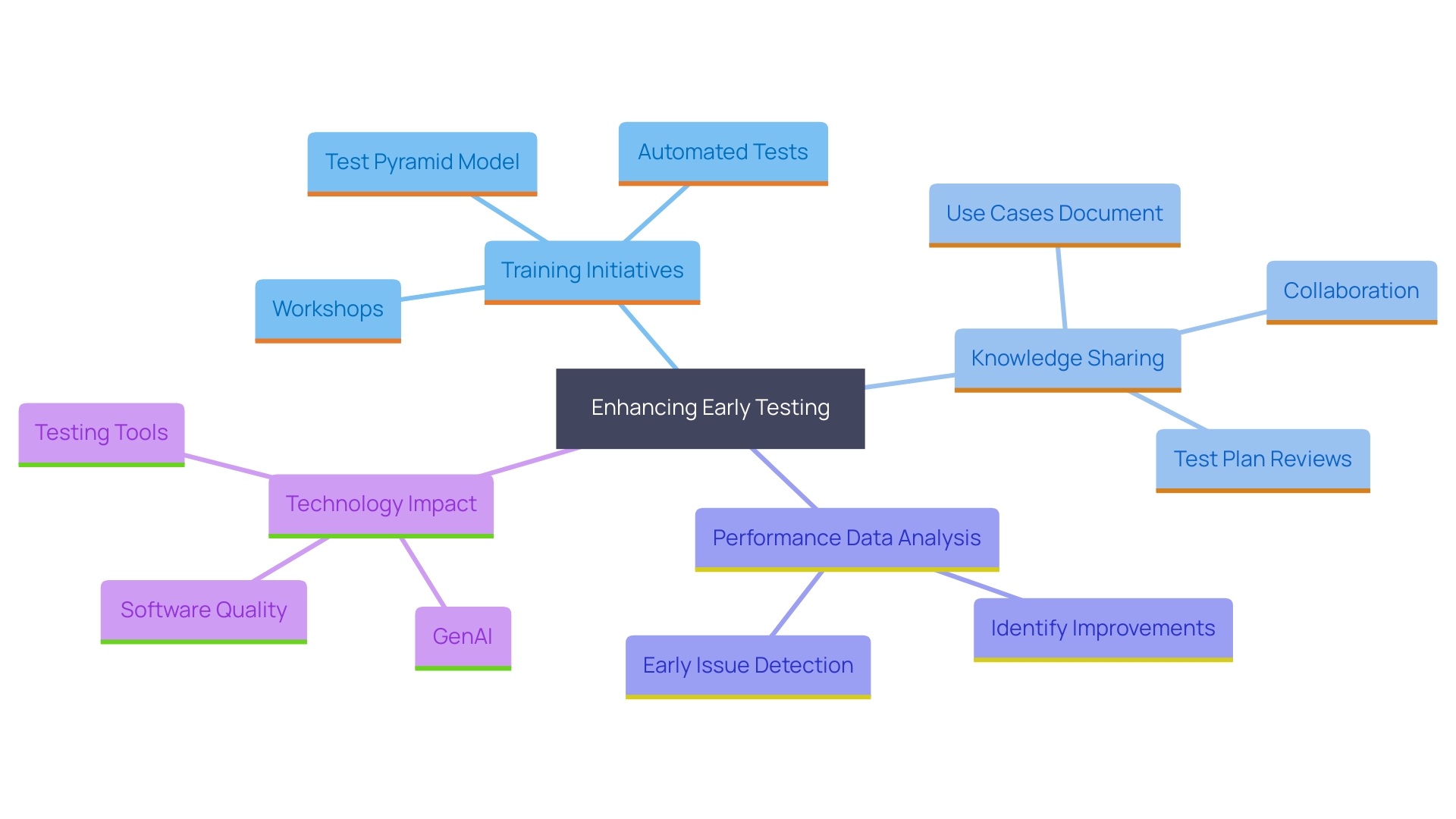Introduction
In the fast-paced world of software development, maximizing efficiency and maintaining high standards of quality are paramount. Shift Left Testing fundamentally transforms traditional testing approaches by prioritizing early-stage quality assurance within the development lifecycle. This proactive strategy embeds testing into the initial phases of requirements gathering and design, enabling teams to identify and resolve defects much earlier.
By shifting testing responsibilities leftward, this approach significantly reduces the costs and time associated with fixing issues later in the development cycle, while simultaneously enhancing the robustness, security, and reliability of software products. As companies strive for faster release cycles and higher-quality applications, the adoption of Shift Left Testing becomes essential, aligning seamlessly with modern DevOps practices to ensure superior outcomes.
What is Shift Left Testing?
The method signifies a revolutionary strategy in the software creation process by emphasizing early-phase evaluations. By embedding quality assurance measures right from the requirements gathering and design stages, teams can detect and address defects sooner. This early intervention reduces both the cost and time associated with later-stage fixes and significantly boosts the overall quality of the software. The conventional 'test after creation' model, often observed in waterfall methodologies, postpones the detection of possible problems until they become more intricate and expensive to address. In contrast, Shift Left Testing incorporates evaluation activities throughout the creation process, promoting continuous feedback and collaboration among stakeholders.
By shifting evaluation responsibilities leftward in the development timeline, teams can ensure that software is more robust, secure, and reliable. This proactive strategy is especially vital in large-scale projects, where the complexity and scope require thorough early evaluations to reduce risks and guarantee adherence to standards. Real-world applications, such as those seen with Prodzilla, demonstrate how early testing phases during requirements, design, and planning can lead to more effective and efficient outcomes.
In today's rapidly changing software environment, embracing early testing is not just advantageous but crucial. It aligns with modern DevOps practices, enhancing speed, efficiency, and quality in the creation cycle. Consequently, the effect of early testing on the future of software creation is significant, identifying it as a crucial practice for providing high-quality applications that fulfill user expectations and business objectives.

Benefits of Shift Left Testing
The Shift Left Testing approach offers numerous advantages. Firstly, it significantly enhances the overall quality of the software by detecting issues early through various tests such as unit tests, performance tests, and integration tests. This early detection minimizes bugs in later stages, reducing the risk of post-launch problems and improving user experience and satisfaction. Secondly, it fosters better communication and collaboration among teams, as developers, testers, and business analysts work closely together from the start. This collaboration leads to a shared understanding and a proactive approach to problem-solving, resulting in higher-quality software. Furthermore, it can result in quicker release cycles, as initial evaluations assist in optimizing the creation process, minimizing the necessity for significant revisions. Additionally, integrating security testing from the start helps identify and address vulnerabilities early, reducing the risk of security breaches and making the final product more robust and secure. Ultimately, Early Testing is economical, as discovering and resolving problems early in the creation process is much less expensive than tackling them post-deployment, stopping defects from becoming deeply embedded in the codebase and conserving time and funds.
Challenges of Implementing Shift Left Testing
Implementing Shift Left Testing, despite its numerous benefits, comes with its own set of challenges. A primary obstacle is the significant cultural shift it demands from teams, requiring changes in mindset and processes. Research indicates that resistance to change often arises when it's imposed without consultation, leading to a sense of loss of control and autonomy. To counter this, it's crucial to approach change management with empathy and inclusivity. Engaging team members in the process, giving them a voice, and addressing their concerns can mitigate resistance effectively.
Moreover, organizations may encounter resistance due to existing workflows or a lack of adequate training. Creating an environment that emphasizes automated evaluations as a crucial element of the process is strongly recommended. This encompasses training developers in evaluation practices and tools, fostering a sense of ownership over code quality, and creating a shared understanding of project objectives. For instance, a leadership-first approach, where leaders undergo training before their teams, can be effective. This method was successfully employed in the rollout of the Keys to Comprehension Routine, where administrators partnered to teach lessons, experiencing firsthand the implementation challenges and strategies.
Ensuring that all team members are on board and equipped to adapt to this new approach is crucial for successful implementation. This includes providing comprehensive training and the right tools, fostering open communication, and adopting an incremental approach to implementation. As the approach that prioritizes early testing integrates it sooner in the creation cycle, it brings significant enhancements in speed, efficiency, and quality, making it a vital practice in contemporary DevOps.
Best Practices for Implementing Shift Left Testing
Effectively implementing Shift Left Testing requires organizations to prioritize early training and engagement of all stakeholders. This involves fostering a culture where collaboration and communication are paramount. By establishing clear channels for interaction, teams can share a unified vision, which leads to higher-quality software development. Utilizing automation tools is essential to enable ongoing evaluation and incorporate these processes into the CI/CD pipelines. For instance, tools that offer unit tests, performance tests, integration tests, and automated tests can significantly enhance accuracy, consistency, and coverage.
Furthermore, incorporating AI-powered tools can automate repetitive tasks, allowing testers to focus on more complex and strategic activities. AI-driven evaluation tools can analyze vast amounts of data, predict potential defects, and provide intelligent test case generation, thereby improving the efficiency and effectiveness of the evaluation process. Consistently assessing and enhancing evaluation strategies based on feedback and performance metrics is essential. This repetitive method guarantees that evaluation techniques develop, further improving the efficiency of the Early Intervention approach.
By shifting evaluation activities earlier in the development timeline, organizations can identify and resolve issues at a point when they are simpler and less expensive to address. This proactive approach reduces the risk of security breaches, data leaks, and potential threats, making the final product more robust and secure. Additionally, this leads to high-quality, more stable, and secure applications, ultimately improving user experience and satisfaction.

Cultural Shift and Team Collaboration
Creating a culture that supports Shift Left Testing requires a commitment from leadership and collaboration across all team members. This approach elevates software quality by catching issues early, leading to a more robust and secure end product. Encouraging a collective obligation for quality and incorporating evaluation into the daily workflow aids in recognizing and tackling vulnerabilities from the beginning. This proactive methodology not only enhances user satisfaction but also reduces post-launch problems, positioning the company as a reliable software provider.
Promoting open conversation and input is essential for closing divides between creation, testing, and business teams. Such collaboration fosters a shared vision, resulting in higher-quality software and cost savings by preventing defects from becoming deeply ingrained in the codebase. However, shifting to this practice can disrupt team dynamics and require overcoming organizational boundaries. 'Overseeing these modifications is essential to utilizing the complete advantages of Early Testing, ultimately resulting in a more unified and effective development process.'.
Overcoming Challenges and Continuous Improvement
To overcome the challenges related to executing Early Testing, organizations should prioritize continuous enhancement through focused initiatives. Regular training sessions and workshops are crucial for equipping team members with the necessary skills and understanding for successful execution. Knowledge-sharing initiatives further bolster this by fostering a collaborative culture where best practices are readily exchanged.
In addition, gathering and analyzing performance data is vital for identifying areas of improvement. This data-focused method guarantees the strategy progresses and adjusts to fulfill the organization's evolving requirements. According to the World Quality Report, modern methods of software testing can shift the perception of QA from a cost center to a substantial source of cost savings and ROI. For instance, leveraging effective reporting and decision-making processes, as highlighted by industry experts, can accelerate work and significantly enhance overall efficiency.
Moreover, the rapid evolution of technology, such as GenAI, has emphasized the importance of software quality as a key differentiator in today's competitive market. Platforms like SmartBear Connect provide unique opportunities to share best practices, risks, and benefits of AI advancements, further driving the implementation of Shift Left methodologies.
Implementing these strategies not only addresses the challenges but also aligns with the broader trend of reducing cognitive load and enhancing feedback loops, which have been shown to positively impact team productivity and organizational outcomes.

Conclusion
The implementation of Shift Left Testing stands as a pivotal transformation in the software development lifecycle, fundamentally enhancing quality and efficiency. By prioritizing early-stage testing and integrating quality assurance from the outset, teams can identify and resolve defects sooner, leading to a reduction in both time and costs associated with later-stage fixes. This proactive approach not only bolsters the robustness and reliability of software products but also aligns seamlessly with modern DevOps practices, positioning organizations for success in an increasingly competitive landscape.
The benefits of adopting Shift Left Testing are manifold. Enhanced software quality, improved team collaboration, faster release cycles, and cost-effectiveness emerge as key advantages. Early detection of issues minimizes post-launch complications, ultimately leading to greater user satisfaction.
Furthermore, fostering a culture of shared responsibility for quality and integrating testing into daily workflows ensures that vulnerabilities are addressed proactively, reinforcing the overall integrity of the software.
While the journey toward implementing Shift Left Testing may present challenges, such as cultural shifts and resistance to change, these can be effectively managed through continuous training, open communication, and a commitment to collaboration. Organizations that embrace these best practices not only overcome obstacles but also set the stage for ongoing improvement and innovation. By investing in this transformative approach, companies can enhance their software development processes, leading to higher-quality applications that meet and exceed user expectations.
Frequently Asked Questions
What is Shift Left Testing?
Shift Left Testing is a software development approach that emphasizes early-phase evaluations and integrates quality assurance measures from the requirements gathering and design stages. This proactive strategy aims to detect and address defects sooner, improving overall software quality.
How does Shift Left Testing differ from traditional testing methods?
Unlike the conventional 'test after creation' model often used in waterfall methodologies, Shift Left Testing incorporates evaluation activities throughout the development process. This allows for continuous feedback and collaboration, facilitating early detection of issues and reducing the time and cost associated with later-stage fixes.
What are the benefits of implementing Shift Left Testing?
Improved Quality: Early detection of defects enhances overall software quality. Faster Release Cycles: Initial evaluations optimize the development process, allowing for quicker releases. Better Collaboration: Encourages communication among developers, testers, and business analysts. Cost Efficiency: Identifying issues early is less expensive than resolving them post-deployment. Enhanced Security: Integrating security testing early helps identify vulnerabilities before they escalate.
What challenges might organizations face when implementing Shift Left Testing?
Organizations may encounter resistance to the cultural shift required for effective implementation. Existing workflows, a lack of training, and concerns about losing control can hinder progress. Addressing these issues through empathy, inclusivity, and robust change management strategies is essential.
How can organizations successfully implement Shift Left Testing?
Training: Provide comprehensive training for all team members on evaluation practices and tools. Automation: Utilize automation tools to facilitate ongoing evaluations within CI/CD pipelines. Stakeholder Engagement: Foster collaboration and communication among all stakeholders to create a unified vision. Incremental Approach: Adopt a gradual implementation strategy to allow teams to adapt comfortably.
What role does technology play in Shift Left Testing?
AI-powered tools can automate repetitive tasks and analyze vast amounts of data, improving the efficiency and effectiveness of the evaluation process. Utilizing automation tools helps maintain accuracy and consistency in testing, which is crucial for the Shift Left approach.
How does Shift Left Testing impact user experience?
By catching issues early in the development cycle, Shift Left Testing leads to the creation of more robust, secure, and high-quality applications. This proactive approach ultimately enhances user satisfaction and reduces post-launch problems.
Why is fostering a supportive culture important for Shift Left Testing?
Creating a culture that promotes collaboration and open communication is essential for successful implementation. It helps bridge gaps between development, testing, and business teams, ensuring a shared commitment to quality and reducing the likelihood of defects becoming ingrained in the codebase.
What ongoing strategies can organizations adopt to enhance Early Testing execution?
Organizations should prioritize continuous improvement through regular training sessions, knowledge-sharing initiatives, and performance data analysis. This iterative approach ensures that evaluation strategies evolve and adapt to meet changing organizational needs.
What is the future significance of Shift Left Testing in software development?
As software quality becomes a competitive differentiator, embracing Shift Left Testing aligns with modern DevOps practices. It is crucial for delivering high-quality applications that meet user expectations and business objectives, ultimately shaping the future of software creation.




